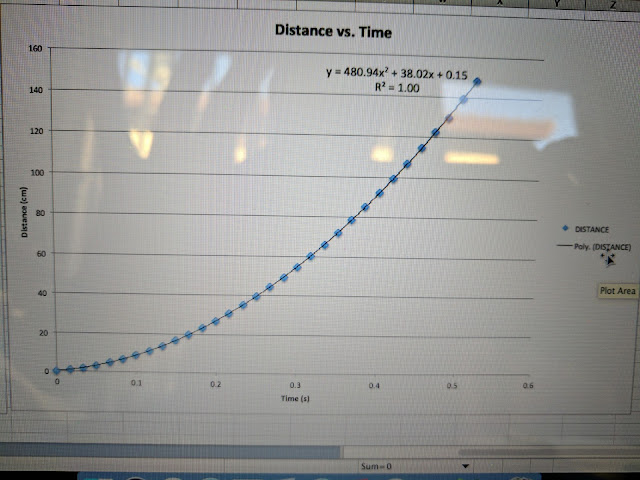Lab 4: Trajectories
Joel Cook
Nina Song
Lab performed on March 14, 2017
In this lab, we were attempting to predict the trajectory of an object.
Introduction: Through experimentation, kinematics, and projectile motion, we are able to calculate the speed of an object rolling off of a track and predict where the object will land when the conditions are changed.
Apparatus and Procedure: In this lab, we used two pieces of aluminum v-channel to form a track for a steel ball to roll on, as pictured below. One end of one of the pieces was elevated to increase the velocity of the ball consistently for all five trials.
A piece of paper was taped to the floor with a carbon paper taped to the top at approximately the distance we expected the ball to fall to. This was done in order to record the exact position that the ball strikes the floor each time. We can then measure the distance from the end of the track to the where the ball strikes (ΔX) and the distance from the end of the track to the floor (ΔY).
From the recorded distances we are able to calculate the speed of the ball as it leaves the track, as shown below. The uncertainty in the measurements for distance are shown after the value measured.
As shown in the calculations above, by using the kinematics equations for displacement, vertically and horizontally, we are able to substitute for time and solve for initial speed, or the speed of the ball as it leaves the track.
In the second part of the lab, we leaned a board against the table in the path of the falling ball and measured the angle.
We measured the angle as 49.0 +/- 0.5 degrees. As shown below, knowing initial speed and the angle we can derive an expression for how far down the board the ball will strike (d).
As shown, we calculated that the ball would strike the board 0.939 meters down the board. We taped a piece of paper and carbon paper, as before, to the board where the ball would land. We performed five trials and measured that the ball landed 0.915 +/- 0.005 meters down the board.
Conclusion: We were able to predict the location that the ball would strike the board with good accuracy. This calculation would have been more accurate but there was uncertainty in our measurements. The uncertainty in our displacement measurements and angle measurements reduce the accuracy with which we can predict the striking of the ball. In addition, errors may have existed in our lab that went unnoticed. The track may have moved without noticing and the board may have moved when struck each time by the ball.
The propagated uncertainty was calculated in this lab and is shown below. The uncertainty in the final calculation comes from the uncertainty in measuring horizontal displacement, vertical displacement, and angle of the board. First, dVo was calculated from the uncertainty in x and y. The result of this was used to calculate the dd using the uncertainty in Vo and the uncertainty in the angle.
The calculation for the distance down the board that the ball would strike (d) is shown as 0.939 +/- 0.051m. Our measured distance of 0.915 meters was off by 0.024 meters, which is well within the uncertainty calculated in the propagated uncertainty above. Therefore, our lab was successful.


























